
Hiking Dude Blog
2025 2024 2023 2022
2021 - Oct Sep Aug Jul Jun Mar Jan
2020 2019 2018 2017 2016 2015 2014 2013 2012 2011
08/30/2021

Following my blog for awhile will have made you aware that I have evolved to no-cook food on my long hikes. This eliminates the weight of stove, fuel, and cooking utensils. It's a fine way to go unless you absolutely must have your coffee in the morning or a hot meal at the end of the day. When I'm on a trek with my wife, I slow down and we take a stove since she still looks forward to hot food.
When the fine folks at RightOnTrek.com asked me to give their backpacking meals a try, my Wyoming adventure this summer turned out to be a good opportunity to do so since we weren't doing big miles and someone else was planning to bring a stove anyway. All I had to do was carry an extra fuel canister.
RightOnTrek has a dozen dinner meals and a half dozen breakfasts to choose from. I tried six of their meals and every one of them was a hit for ease, taste, and calories.
If you'd like to easily get all the food for your trek, the RightOnTrek has developed a Menu Planner where you can create a meal plan for up to two weeks that includes all meals as well as snacks. Their tool puts together food that provides the amount of calories you define and then charges you 1 cent per calorie. An example 5-day trek with 3000 calories per day took me less than 1 minute to create and had a price tag of $150. This is a great tool for someone wanting to spend less time planning food and more time hiking.
Alternatively, you can just purchase the specific meals you want and gather your own snacks and extras - this is what I did.
All the meals I tried tasted great, filled me up, and were easy to make. Here's my meal-by-meal scorecard: (click a pic for large view)
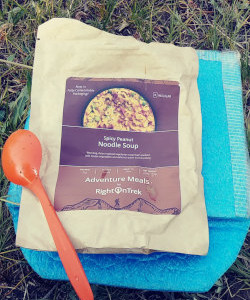 Meal 1 - Spicy Peanut Noodle Soup
Meal 1 - Spicy Peanut Noodle Soup
Score: 9
Pro: The soup was excellent, hot, and filling.
Con: 3 little packets to open and add to the noodles - peanut butter, hot sauce, & soy sauce. It tasted great, but all the packets were a pain and created lots of small pieces of garbage and messy drips.
Other: Since it's soup, you can add as much water as you want. Especially if it's a cold, dreary day, I add extra water so I'm enjoying the warmth longer and helping with hydration.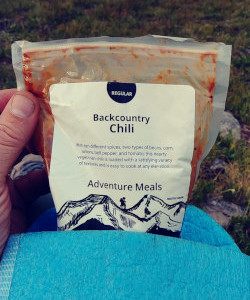 Meal 2 - Backcountry Chili
Meal 2 - Backcountry Chili
Score: 10!
Pro: Simplest meal, and definitely my favorite. Very tasty and really spicy. I found that 6oz was a good meal size. It's vegetarian but still has plenty of protein from beans and lots of flavor from corn, rice, bell pepper, onion, and tomato powder.
Con: Might be too spicy for some.
Other: Really, this was good! Even the sump water tasted good.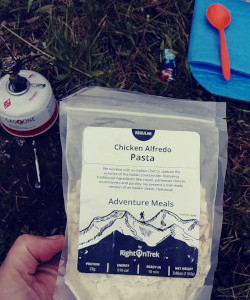 Meal 3 - Chicken Alfredo Pasta
Meal 3 - Chicken Alfredo Pasta
Score: 7
Pro: Chicken chunks rehydrate better than any other meat and it gives this a real meal feel. The mushrooms also felt and tasted like mushrooms.
Con: This one was kind of bland, but tasted fine. It's alfredo, so it's not supposed to have much zing.
Other: It's amazing how powdered milk, cream, and parmesan cheese can turn from lightweight powder back into smooth, tasty food.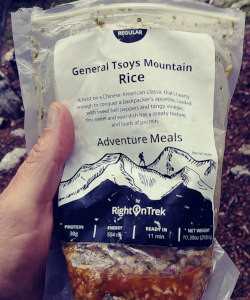 Meal 4 - General Tsoy Mountain Rice
Meal 4 - General Tsoy Mountain Rice
Score: 9
Pro: Great tasting and fast rice meal. I've had poor luck with rice before, but this rehydrated perfectly.
Con: This meal had four tiny packets to add, and many steps in the instructions. Fortunately, you can skip all the instructions (see below).
Other: I think I could live off this and the chili for a month in the wilderness and not complain about meals.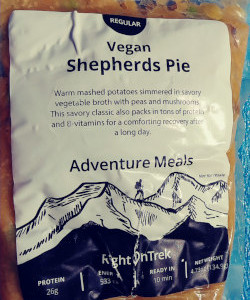 Meal 5 - Vegan Shepherd's Pie
Meal 5 - Vegan Shepherd's Pie
Score: 9
Pro: Mashed potatoes really fill you up. It tasted pretty much like what I make in my dutch oven, only super fast to prepare.
Con: Too much pepper taste for me.
Other: I think there was a mistake in the packaging of ingredients. The instructions did not match the included packets. There was a packet of hot sauce included that was not mentioned, and only 1 oil packet when 2 were mentioned in the instructions. I just cooked it all! My friend from Australia was on this trek with me and he got pretty upset when I said it was Vegan shepherd's pie - he said that's just not right. :-)
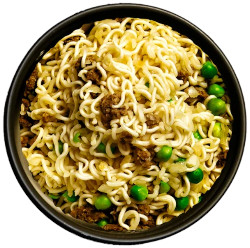 Meal 6 - Beef Ramen Soup
Meal 6 - Beef Ramen Soup
Score: 8
Pro: Like all the rest, the ramen tasted great. The 'meat' rehydrated fine and had a good feel of substance.
Con: It was ramen noodles, so they're always pretty good - but it was just ramen, and little packets of sauces.
Other: It was raining too much for a photo of this meal, so this is what it's supposed to look like. :-) The description says it contains ground beef, but it sure seemed like TVP (textured vegetable protein). Either way, it was good. Well, I found the packet of oil that was missing from the Shepherd's Pie meal - probably someone dropped it in the wrong bag when packaging.
- They have from 21g to 29g of protein and 515 to 577 calories per each regular size meal.
- Most meals had a few little sauce packs that had to be opened and added. Things like soy sauce, peanut butter, oil, hot sauce, ... Besides the oil, I think most of those could be dried spices packed right in the meal to save the futziness, trash, and mess.
- Every meal tasted great and there was plenty of food every time.
- Calories and weight are similar to other well-known brands. Price seems to beat others by about 15% or so. If you have 4 people, buy their 'Serves 4' package size and one person eats for free, or about a 25% additional savings - so that puts their price in a very competitive spot. The larger size also saves on weight and trash.
- A big reason for using these bagged meals is to make 'cooking' easy - just add hot water and wait. These meals have multi-step instructions that have you put the contents in a pot, boil awhile, add packet ingredients, and then wait. I'm sure the detailed instructions work great, but Forget That! I just dumped the packets into the bag, poured in hot water, set it in my cozy for 15 minutes, then ate it. Absolutely every meal rehydrated wonderfully and tasted very good.
You can see my blue cozy in some of the photos. A cozy makes life much easier and meals hotter. The insulation keeps the water hotter longer and lets you set the bag anyplace to rehydrate. It can also be used as a small cushion/dry/clean spot to sit. I have Cozy Instructions for my old cozy, but the one I use now is just blue foam folded over and taped - works just as well. - Besides the ease of cooking, rehydrating in the bag also makes clean up fast and simple. No pots to clean! Just pour a little more hot water in the bag, seal it, and shake it. Then drink the water and roll up the bag into clean trash. Presto! That's called Sumping and wastes no food and leaves no crumbs in the woods.
- One concern about rehydrating directly in the bag that the food came in is the possibility of punctures and then leakage. When I made my Shepherd's Pie, it had a tiny pinhole after being tossed around in my pack for 5 days. It did not leak when rehydrating, but did a bit when I sumped the bag. So, just squeeze the bag before opening to check for air leaking out.
- If you like spicier food, it's always a good idea to carry a small 'spice kit' with what you like most so you can jazz up whatever meal you make.
- Oh, and really invest in a long-handled spoon. These bags, like others, are deep and get your hand messy. I'd love to see a shorter, wider bag - like with the zipper opening on the side instead of top. Spoons range from free red plastic in a DQ blizzard, to $5 bamboo, to $30 titanium. They're all about 8 inches long and do the job.
As our society evolves, people are tending to acquire less stuff and we're moving more toward a Sharing System where a person can select a belt sander or pruning shears or whatever off a website, have it delivered, use it, then have it picked up when finished. That one belt sander can be used by 30 people in a month instead of 30 hammers sitting idle in garages for 29 days.
Besides the meal planner on RightOnTrek.com they are also rolling out a gear rental system which puts them right into this new model of business. You can plan your trek, select what gear you need, when and where you need it, and it will be waiting for you at an outfitter near your hike location - along with all the food for your hike. When you're done, you just return the gear and head home with no clean up and storage to worry about. I believe this sort of system will become the norm soon, so it's exciting to see a company embrace and advance it.
It's not too early to think about Christmas gifts for the hiker you know - a selection of meals would stuff a stocking nicely!
(RightOnTrek provided me with these meals to sample in exchange for this post.)
Posted: 08/30/2021
08/27/2021
Today's blog post is from my wife. Last week, she had a canoeing adventure in the Minnesota Boundary Waters Wilderness with friends. And, it included some hiking, so here you go...
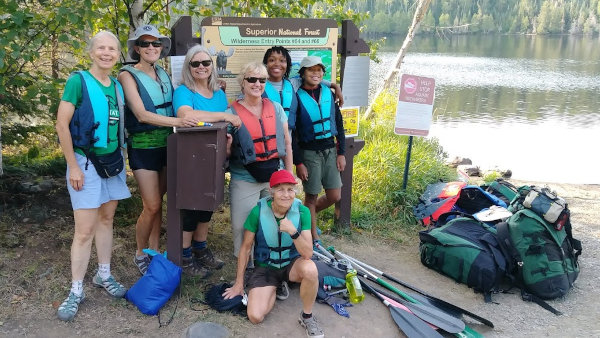
Our group of seven women (ages 15 - 68 with the majority of us over 55 years) spent 4 days in the BWCAW from August 20th through August 23rd, 2021.
Rockwood Lodge & Outfitters provided all of our gear and equipment in an extremely flexible and friendly manner. We decided to pack our own food (more about that, later), and since we were a church group, they offered us very reasonable, non-profit pricing.
We left the Twin Cities at 10:00 a.m. and arrived at Rockwood around 4 p.m. While Mike put together our equipment, we headed over to the nearby Trail Center Lodge for dinner. As always, the food was delicious and the staff cheerful and efficient.
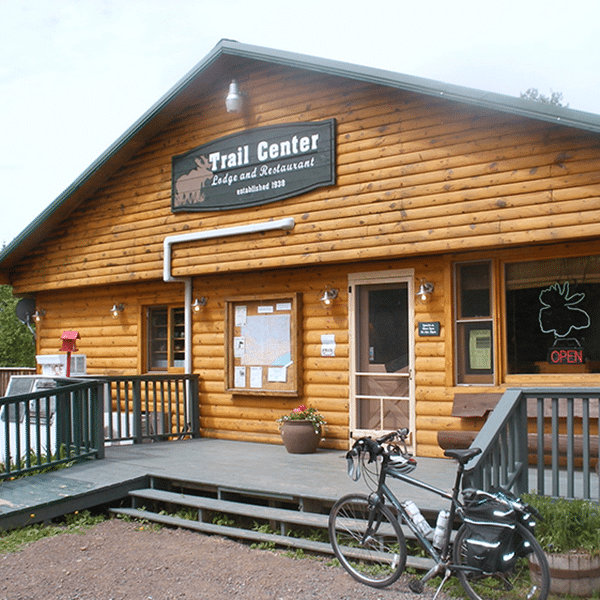
Then we headed back to Rockwood to do a gear/equipment check and begin packing our personal gear and food. Rockwood provided waterproof packs for each person which easily allowed two people to share a Granite Gear portage pack. We spent the night in one of Rockwood's bunkhouses (complete with a bathroom/shower & towels), and chatted with our neighbors who had just completed their trip and were happy to share helpful tips.
We were up and eating breakfast at 7 a.m. with the goal of an 8 a.m. departure time. Mike brought us hot coffee to enjoy with the muffins & grapes that we had brought from home.
After we watched the required video, Carl hauled our three canoes to the East Bearskin Lake entry point (#64), and we were on the water by 9:00 a.m. We paddled east along the south shore of East Bearskin Lake to the portage into Alder Lake. There, we met another group heading home who shared information with us about open campsites on Alder Lake and Canoe Lake. We continued paddling east on the northern finger of Alder Lake to the tip of the west shore peninsula where we checked out an open campsite (#705). It was smaller than we needed, and our plan was to leave the 3-person canoe at the site, and paddle on to Canoe Lake with the other two canoes to see if some of the bigger campsites were available. As we watched nine canoes head past us towards Canoe Lake, we decided that we'd all stay put, make this smaller site work for us, and enjoy a shorter paddle home on Monday.
We scouted the site thoroughly to find usable tent pads for our two 4-person tents and one small 1-person tent. The site had one good tent pad up the path from the fire grate area, and quite a few options for the 1-person tent, but finding a spot for the last tent was a challenge! Since fires weren't allowed in the BWCA due to extremely high fire danger, we were able to set up one of the 4-person tents near the fire-grate area.
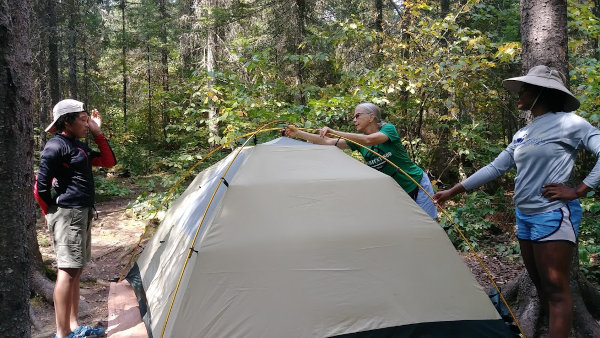
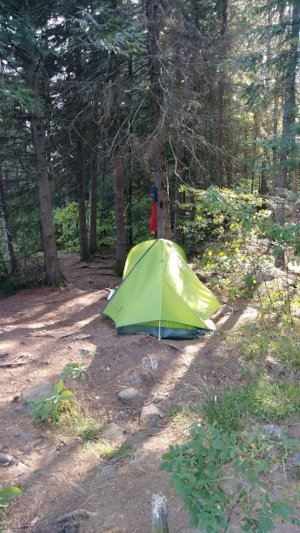
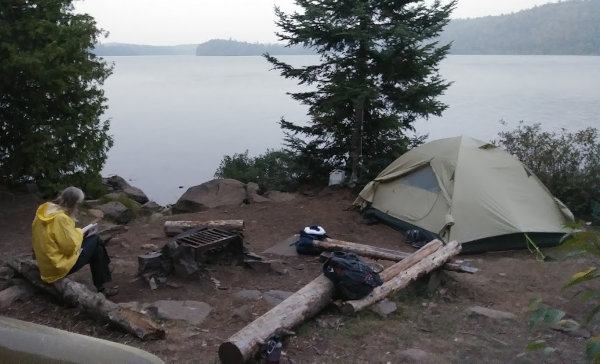
Next, we put up a tarp because we knew the forecast called for rain. This would give us a place to cook & eat meals if it was raining, and allow us to keep our portage packs dry (less weight to carry). We also set up the Platypus gravity water filter provided by Rockwood.
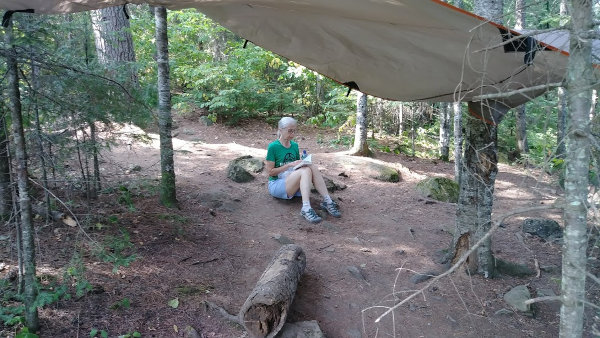
And then came our favorite group building, problem solving activity - hanging the bear bag! Our goal this year was to master the pulley system. We did pretty well, but based on the stories we heard from other campers on Lake Alder and Canoe Lake, it's likely that a bear could have taken our food.
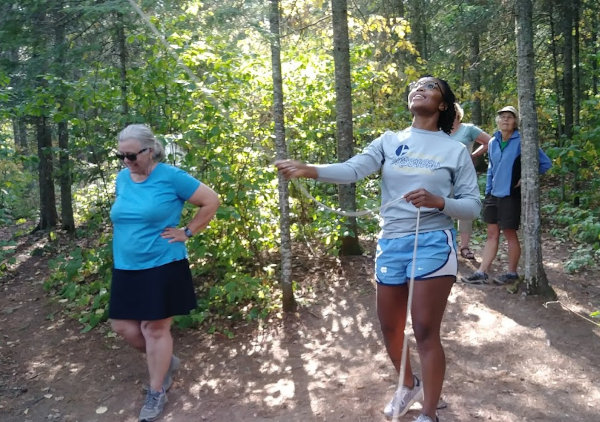
Sierra was our 'rock' star, using her softball skills to get our rope up and over a high branch. Then we used a method where most of the group pulled the food bag rope and a few people pushed up on the bag with paddles to get the bag up as high as we could. We kept all of the food, garbage and our toiletries in the bag except when we were eating.
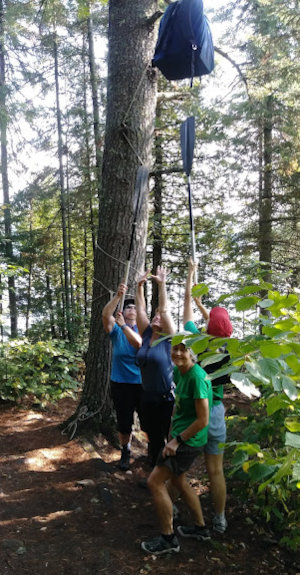
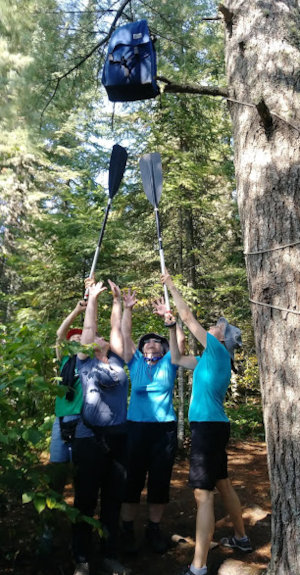
Speaking of bears . . . We met three different groups who had been significantly impacted by a bear stealing their food. This was something we had not encountered before, and certainly gave us pause. One group told of the bear coming into their camp while they were eating breakfast and going to their closed (but not locked because they were eating) bear barrel and taking the barrel of food into the woods. Another group said that the bear climbed the tree and jumped out to pull the food down. The last group reported that the bear clawed the rope tied to the tree trunk, so that the food came down. We were lucky that the bear didn't come to our campsite, because if it had, we would have likely lost most of our food and had to head home early.
We decided to pack our own food to save money, have the food we like to eat and have the right amount of food. We only needed one stove, a couple of pots with spoons for stirring, bowls, cups & spoons. For breakfast we had options such as protein bars, granola bars, and instant oatmeal packets. We also had hot cocoa mix & instant coffee. For lunch we had bagels, cream cheese, flat bread, sausage, cheese, peanut butter & honey. For snacks we had LOTS of dried fruit (apples, bananas, pineapple, mango & cantaloupe all dried at home the week before the trip), beef sticks, trail mix, candy bars & small bottles of water flavoring. Our dinners included Knorr alfredo noodles with Sweet Sue's chicken breast, Chef's Cupboard 3-bean chili (from Aldi) combined with a 4.5 tube of concentrated tomato paste and Knorr chicken rice with Sweet Sue's chicken breast. For dessert we had Knoppers - a yummy treat reminiscent of S'mores and found at Aldi.
Rockwood lent us nylon zip storage bags so that we could keep our food organized by meal. Each morning we put out the bags for breakfast food, snacks & lunch. Then we each used those options to eat a breakfast of our choice and pack our individual snacks & lunch food for the day using personal ziplock bags that we reused throughout the week
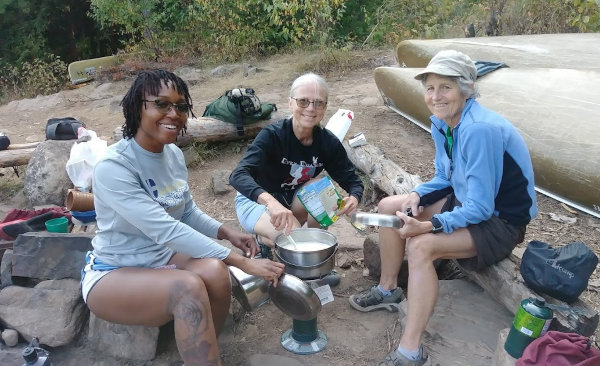

Saturday was a cloudy, windy day, but we headed out on a day trip with our rain gear, lunch/snack bags, TP, first aid kit, water, Katadyn water filter pump, sunscreen & bug spray. Our plan was to paddle & portage to Moon Lake and perhaps hike a bit on the trail. It turned out that the portage from the north finger of Alder into the north finger of East Bearskin was an unmaintained portage. We had to carry the canoes over several downed trees as we made our way along the steep trail. It was NOT fun. Once we were in East Bearskin, the wind picked up and we were paddling in white-caps. We stopped as a group to make decisions about continuing to Moon Lake, returning via the longer water route, or returning via the unmaintained portage with less time on the water. We decided that paddling in the wind and white-caps wasn't a safe choice, and although we REALLY didn't want to repeat the unmaintained portage, that's what we did. Our return to the campsite was challenging, but we made it safely and enjoyed some much needed rest for the remainder of the afternoon and hot chili for dinner.
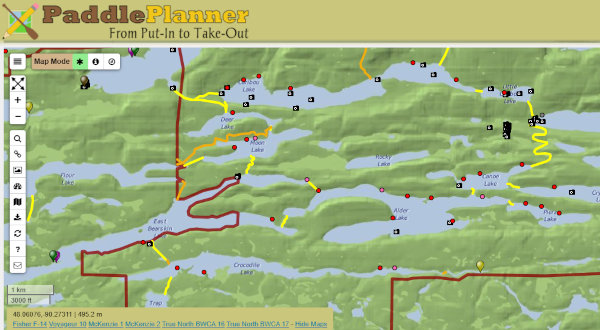
Sunday was, as we expected, sunny with very mild winds. We filled our day packs for our adventure to Johnson Falls, including swimsuits and towels. When we arrived at the Zig Zag portage at the far east end of Canoe Lake, we stowed our canoes, paddles & life jackets in the woods, and hiked for 45 minutes to Lower and Upper Johnson Falls. We enjoyed a beautiful lunch break at Lower Falls, and Kelly & Deb braved the cold water for a refreshing swim! Also on Sunday, our youngest & oldest group members learned how to portage the canoes.
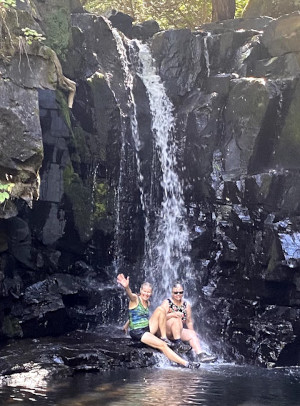
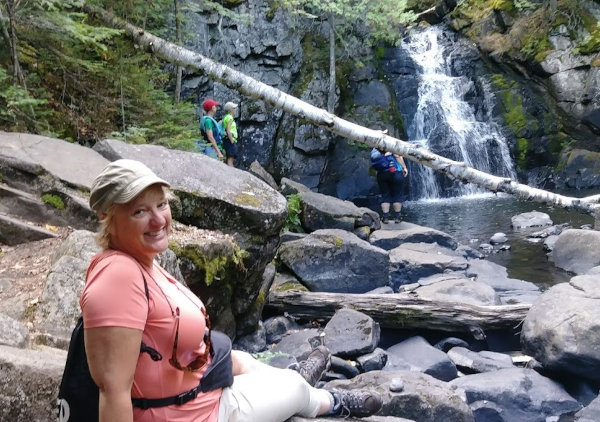
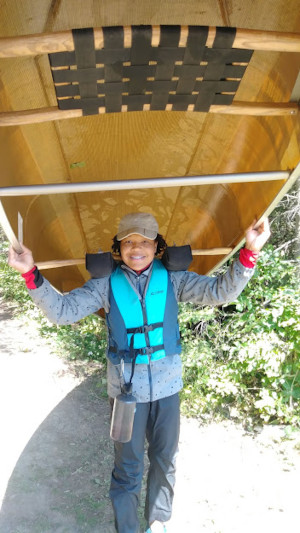
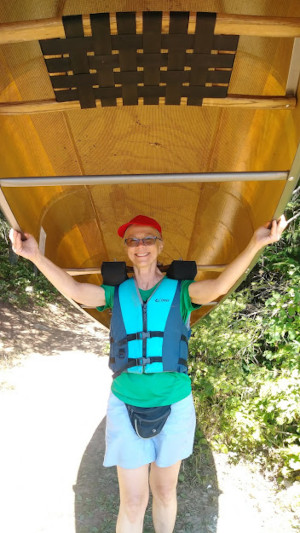
Monday morning we packed up, made sure our campsite was clean, and were on the water by 8:00 a.m. As we headed west on Alder Lake, a canoe with two Forest Service employees stopped us. We were sure that they were going to tell us about the bear problem, but it turned out that they were letting us know that the entire BWCAW was closed due to fire danger (for the first time in 40 years) and that we needed to leave. They had started informing groups to leave on Saturday, and lucky for us, they didn't get to us until Monday.
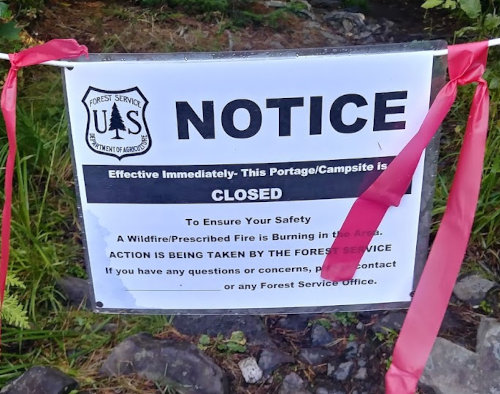
We were able to enjoy our entire stay in the BWCA despite bears and forest fires. Here's a link to our trip on Spotwalla.
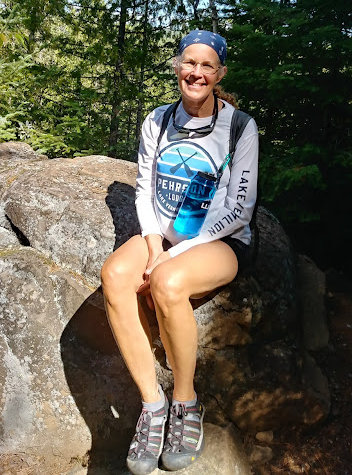
Guest blog by Kelly Kautz
08/12/2021
Last you heard from me, I was done with our short Cloud Peak warm-up 2-night hike and just getting ready for my first horse ride in 12 years. I survived and made it home, so I can finally share the highlights!
Here's the 3-part map of this little adventure. Cloud Peak in the upper-right, then a 5-hour drive to Pinedale on the left, and Cirque of the Towers at the bottom.

The steep and rocky hike into Cloud Peak was short but strenuous. My brother made it, and even managed a couple smiles along the way. We had nice weather while here, but the wildfire smoke was in the air from horizon to horizon.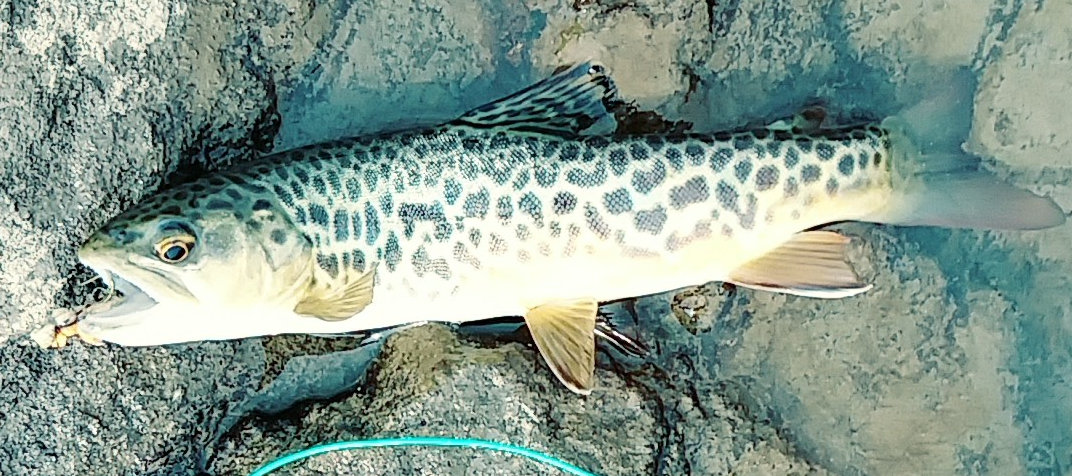
I did some research and found out that I did catch a few Tiger Trout in Long Lake. This beautiful fish is a sterile hybrid created by crossing a female brown trout with a male brook trout. They are created at WY's Story Hatchery and then stocked in a few dozen WY waters as well as other states.
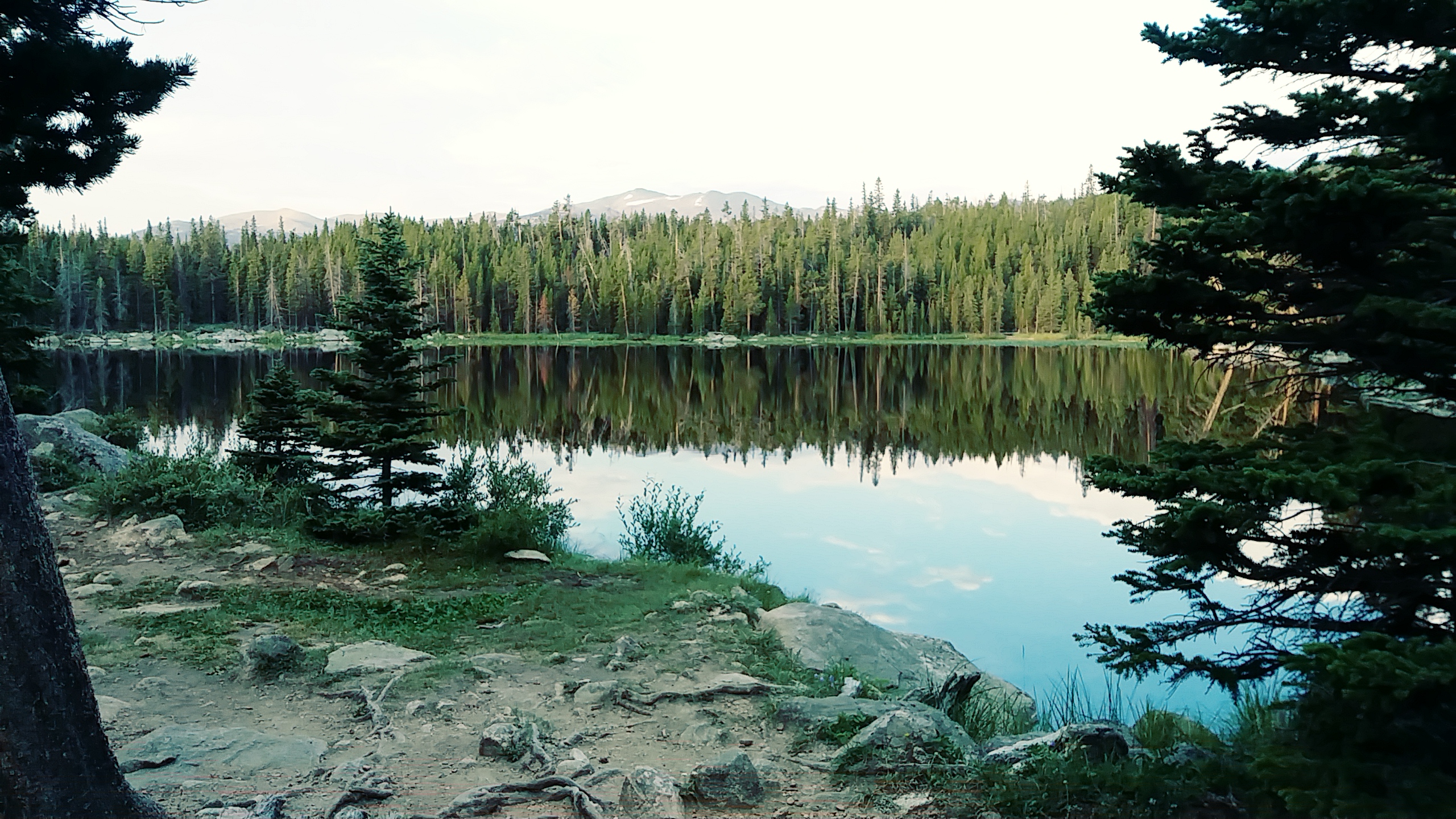
We camped two nights off the trail in the woods near Sherd Lake. Sherd was not productive at all, but our day hike to Long Lake and Ringbone Lake produced dozens of fish, mostly out of Long Lake. Also, Oliver Creek was full of brook trout that weren't picky about what they ate.
A 5-hour drive got us to Pinedale on the west side of the Wind River range. We were a day early, so we got a hotel room and had a whole day to relax. A dozen guys from across the country would all arrive over the next day. We packed our gear into duffels and delivered them to the outfitter for mules to carry in for us the next morning.

I got to spend my 5-hour trail ride on Rosie. She did a great job and didn't get up to much mischief, except she liked to brush up against trees a lot. Probably hoping to knock me off her back.
The ride was a fun experience, but got a bit tedious after a few hours. It is sure a lot faster and easier than hiking, especially going uphill. The horses just keep moving along at a steady pace all day.

When we arrived at our camp location, the outfitters unpacked all our gear, hopped back on their horses, and we were on our own in the wilderness for the next four days. The left us at a spot they called 'Dead Fred' because their story was that one of their horses named Fred had died there a few years ago. He was trying to keep up with some mules and had an accident, breaking his neck or something. Anyway, it was a beautiful spot just off of Pole Creek and within 2 miles of six fishable lakes.
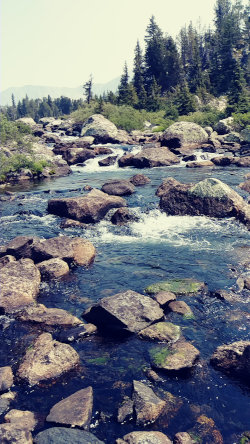
The first day, we fished Pole Creek and caught many brookies along the mile or so section. It's a wonderful creek with many small rapids and pools with aggressive fish. I used a foam black ant dry fly that worked all day.

The second day, we hiked a bit over a mile to a nonamed lake right on the Continental Divide Trail. I caught two lake trout on spinners right away and then caught many brook trout on flies and spinners the rest of the day. The lake trout were deep and did not fight, but the brook trout put up a good fight. We fished the entire perimeter of the lake and climbed over a ridge to fish two other lakes which yielded a few fish each. On the way out, we tried a small but deep overflow lake. It was full of fish.
I hooked what felt like a small fighting brook trout, but then it suddenly stopped fighting and was just heavy like a log. I gradually reeled it in until I could barely make out the form of a very large fish body. Then, that fish swam away and I easily reeled the small trout in. I believe it was a lake trout that bit the small brookie in distress that was on my hook - but I guess I'll never know for sure.
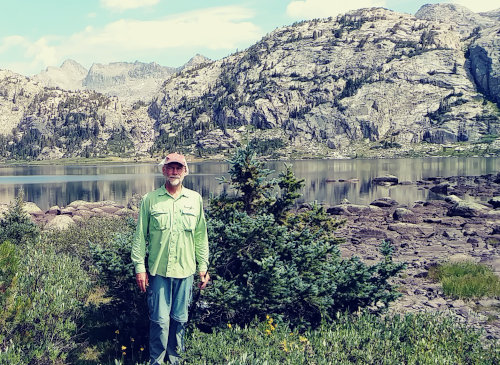
The third day, we hiked up to the two main Cook Lakes. These were big and deep with no surface activity, so I stuck to spinners. We made a large loop hike, catching a fish or two at every spot we tried. One large brookie took a hook too deep, so we carried it back to camp and shared it with the others at dinner. All the other fish were successfully released on this trip.

On our last day, the outfitter was scheduled to arrive between noon and 2pm. I had originally planned to hike south on the CDT to meet my next adventure buddies, but the forecast is for rain the next three days. So, I changed my route and hiked out to the trailhead and get a ride with my brother around the range to Lander. I packed up and started hiking around 9:30am, not knowing how bad the trail would be.
Along the trail, I like to think I'm pretty good at keeping my eyes and ears open. I noticed this moose off to the side as I walked by and we just watched each other for about a minute and then went about our business. Other than him, the only other wildlife was chipmunks, squirrels, and a couple deer.
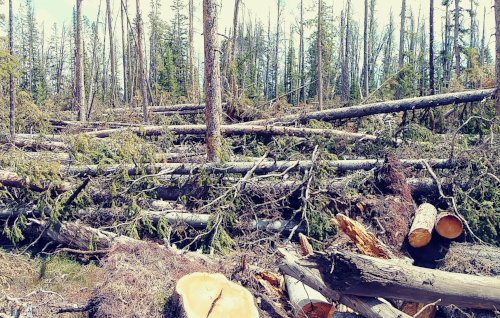
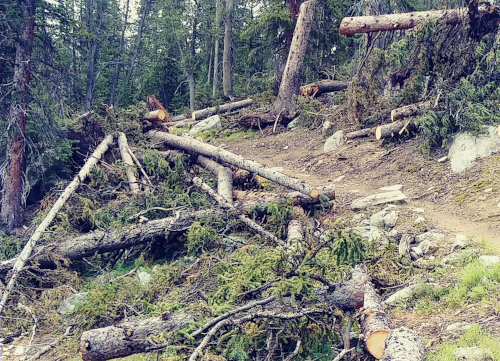
The most remote 2 miles of trail were still impacted by blowdowns from last year. On Labor Day, 2020, a huge windstorm swept through the Wind River Range, knocking over thousands of trees and many of them aimed right for the closest trail passing by. People had a rough time getting out of the wilds for awhile as the roads and then trails were cleared. The lowest 9 miles, as you can see, has all been cleared. A huge effort, especially considering all the cutting inside the wilderness area is done with non-powered saws.

Only about 4.5 miles in from the trailhead, there is a wonderful overlook called Photographer's Point for good reason. It is a spectacular view to the north of Titcomb Basin. Gannett Peak is Wyoming's tallest and is just beyond those three peaks above my left ear.
At the trailhead, I got to relax for a couple hours as the horses sauntered out of the mountains. I actually made it out in less time than the horses! Then, we spent the night at a rented lodge to wash up and share stories before heading out.

A drive south past Big Sandy trailhead and around the range to Lander on the east side got me in contact with my three friends, and sent my brother on his solo drive back to Wisconsin. We each purchased the required permits to cross the Wind River Reservation on a dirt road to get to the Dickinson trailhead and campground, and then headed up the 35 mile drive which takes 90 minutes - actually the last 17 miles takes 75 minutes, it's treacherous. A herd of outfitter horses welcomed us to the campground and we settled in for the night.
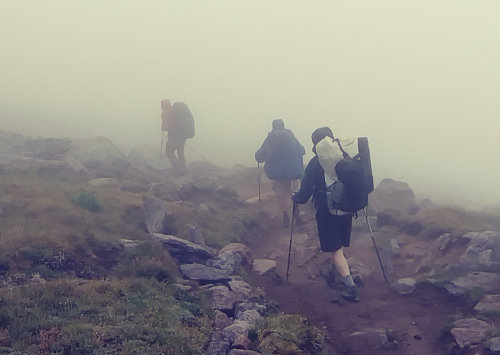
A night at the campground included a little rain and ominous clouds to start our morning hike up, up, up from 9400 feet to 11960 on the shoulder of Mt. Chevaut. The temperature was great except a bit too chilly for the top couple miles. The views were much like this until we reached the top and the clouds lifted a bit. On our way down the other side towards Valentine Lake, we saw a horse train following us, most likely with clients looking for a camping spot.

The first day's hike was pretty strenuous, so we were happy to arrive at the lake before the horses and find a great spot. When the horses came past, it was pretty evident they were intending to use this spot - whew!

Our original plan was to do a 15 mile loop over Washakie Pass and Hailey Pass. After the first day's hike, we shortened that to 12 miles and followed the South Fork of the Little Wind River to Graves Lake, then east to Moss Lake and Dutch Oven Lake. It was a good choice. The hike was wonderful and challenging over beautiful, rough terrain. The fishing was great, too. Gaves Lake has a surprise for anyone that ventures there - a long sandy beach and crystal clear water.
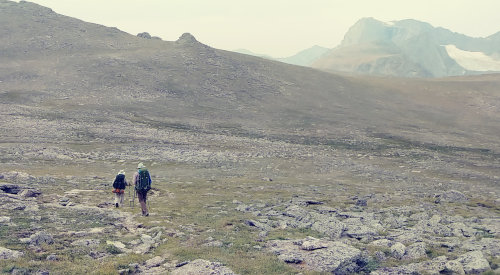
The next morning when we had to retrace our route for 3 miles so we could head south to the Cirque of the Towers. It was fine, but going over the same trail isn't too exciting. When we climbed back up to 11,000 feet, we were gifted with a long, fairly flat walk across a couple miles of tundra plateau. It was very cool and I was thankful that the weather was perfect - lightning up here would be concerning.

After traversing the plateau, we took a very nice, long rest break high on the steep hillside overlooking Lizard Head Meadows, Lizard Head (to the right), and the Cirque of the Towers in the distance. It was just a wonderful place to sit back and soak in the wilderness.
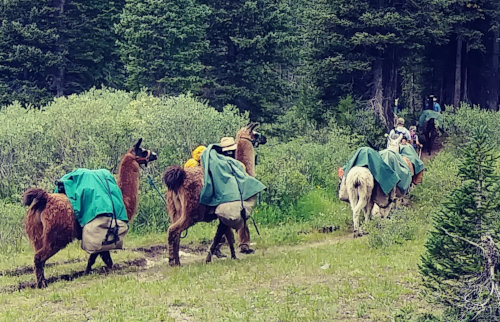
Again, we found a great campsite in the trees and set up. In the early evening, a llama train walked past. I did a little fishing and there were a few sprinkles of rain.
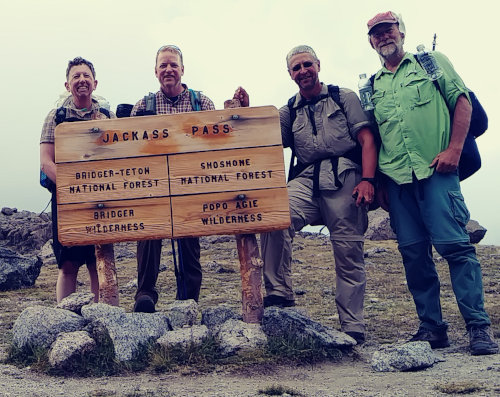
Our fourth day of hiking had us climb out of the Cirque over Jackass Pass and the Continental Divide. On the way up the climb, we crossed paths with a spread out group of macaroons with 8 or 9 dogs off leash and completely unwilling to take responsibility of controlling their animals. Another hiker that had his dog on a leash just ahead of us had three separate instances of their dogs attacking his dog. It was the worst behavior I recall ever experiencing on trail.

The hike was great and dropping into the Big Sandy drainage put us in our fourth basin. As expected, there were dozens and dozens of people on the trail and camping around the area. For one last time, we managed to locate a splendid spot to call home another couple nights. We did get hit with a short, intense rain, but everything dried out just fine.
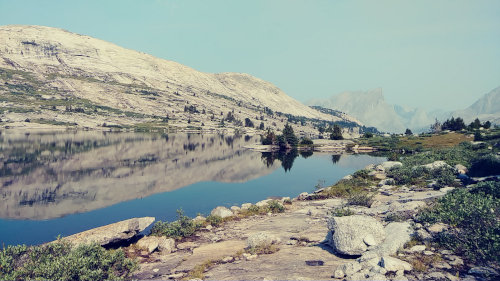
For our last full day, we did a loop hike up through Clear, Deep, Temple, Miller, and Rapid lakes. It took all day, stopping to fish at each one, and we caught fish every place we stopped. The weather was perfect all day long and we saw only a couple other people.

The most wonderful nature part of this trip, in my mind, was the hike between Clear Lake and Deep Lake. The path followed occasional cairns over solid bedrock for a half mile or so. The stream itself just ran over the rock with no real path cut into it yet. Hikers are pretty much free to map their own way up the broad, smooth rock face. Very cool!
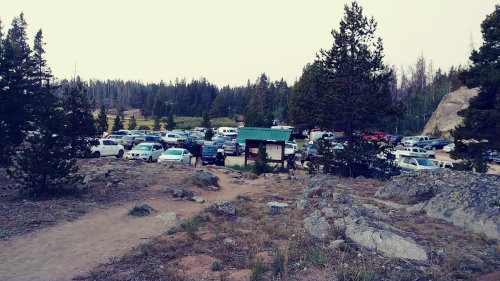
Our last day was a nice, lesisurely 7 mile hike down the Big Sandy valley to the extremely popular trailhead. The trail was cleared of hundreds of down trees, the tread was well used, the weather was most excellent, and it was almost all downhill. A great way to end our trek, passing over 60 people heading up into the mountains. Finally, after six days in the mountains, covering about 55 miles, we saw a moose! - walking through the trailhead parking lot packed with almost 200 cars. Imagine that!
We met our shuttle back to Lander, retrieved the vehicle from the Dickinson trailhead, and drove through the night to reach home around 7am. I got the midnight to 3am driving shift - an hour rain storm and two 12-mile construction zones made it a bit more exciting.
If you fish in Wyoming mountains, I would highly recommend using 'Little Jake' spinners or any terrestrial dry fly, such as grasshopper or ant. I wore out three flies and only lost one in a pine tree. I'd also recommend you remove hook barbs to reduce injury to the dozens of fish you'll catch and release.
07/25/2021
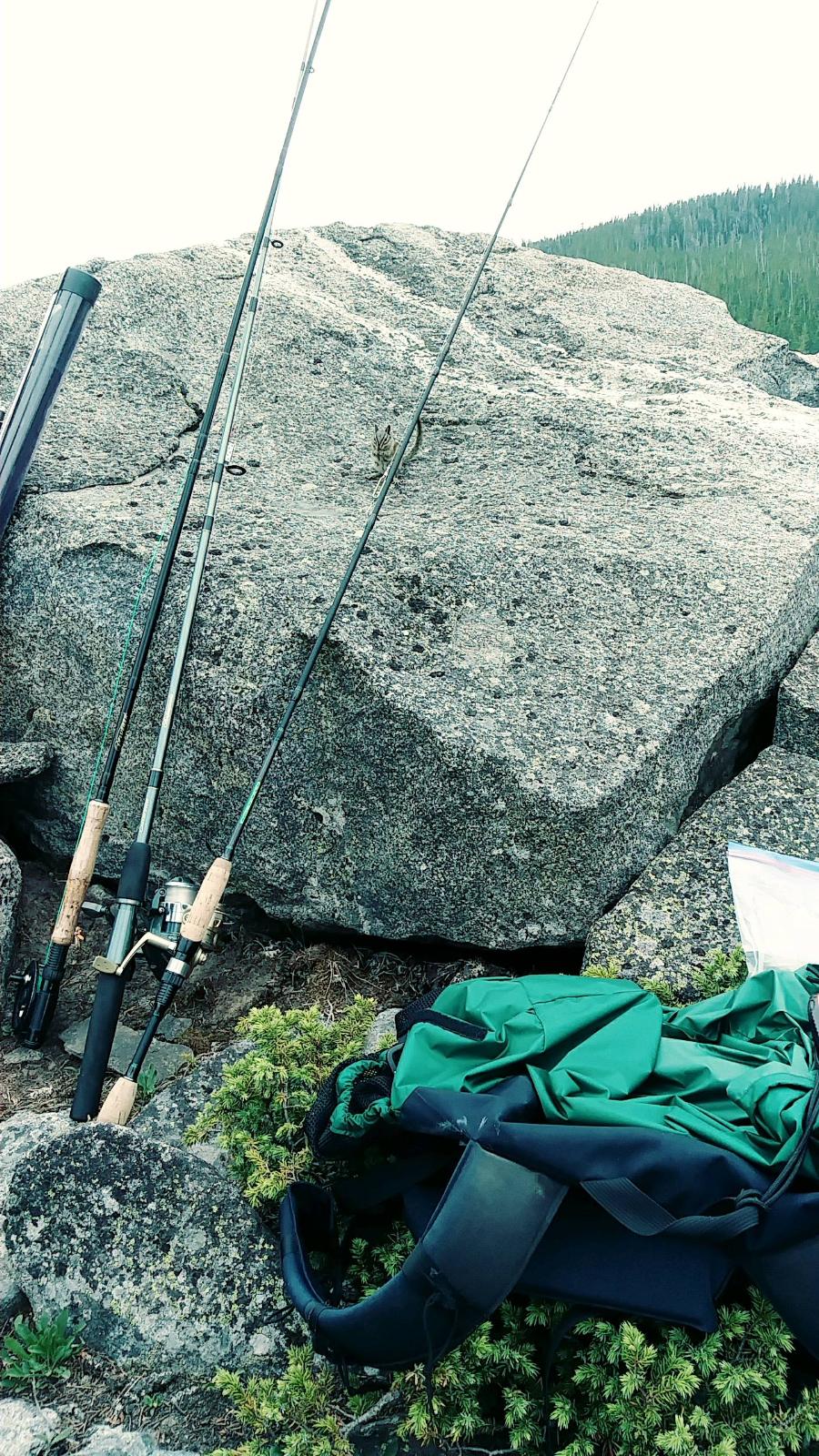 Yeehaa ! !
On the way to the horse trailhead this morning. We met our trail guides last night and dropped off all our gear for the mules to carry up the mountain for us. Now, 9 of us get to play 'city slickers' today and ride nose to butt up the trail for 5 hours to some top secret lakes packed with huge trout.
Last time I was on a horse was 2008 at Philmont scout ranch so this should be fun! Plenty of hiking between lakes for the next few days.
Yeehaa ! !
On the way to the horse trailhead this morning. We met our trail guides last night and dropped off all our gear for the mules to carry up the mountain for us. Now, 9 of us get to play 'city slickers' today and ride nose to butt up the trail for 5 hours to some top secret lakes packed with huge trout.
Last time I was on a horse was 2008 at Philmont scout ranch so this should be fun! Plenty of hiking between lakes for the next few days.Posted: 07/25/2021
07/24/2021
 Cobbling a bunch of activities together without a specific long trail to hike makes for a very fluid plan.
Cobbling a bunch of activities together without a specific long trail to hike makes for a very fluid plan.Today we decided to hike out instead of fishing one more lake which we figured would be pretty much the same as yesterday. So, it's a lot easier hiking downhill for 2 miles and we started driving west once again around 10am.
On the hike out, we crossed paths with a group of day hikers coming in - they were a group from my church so it was a surprise to run into them.
Arriving in Pinedale, we found a hotel and spent the afternoon showering, resting, shopping, and exploring downtown Pinedale. It's a busy small Wyoming townand seems to be doing pretty well, especially compared to all the other struggling towns we've passed through.
Many of the other 'Horse Gang' showed up and we had dinner together. These guys are old friends and acquaintances that get together for some form of fishing vacation every year. This year, it's a horseback ride into the mountains for a few days of camping and fishing.
So, resting up between little adventures. Checking the weather, I expect my plans will change again tomorrow.
Posted: 07/24/2021
07/23/2021
 Red Squirrels and Canada Jays let us know it was time to start the day. I had about the worst night of sleep I can remember, but gave in to their insistence around 6am.
Red Squirrels and Canada Jays let us know it was time to start the day. I had about the worst night of sleep I can remember, but gave in to their insistence around 6am.I'm sharing this rambling adventure with my brother who was having better luck sleeping. So, while he rested, I hiked the 100 yards to Sherd Lake with my spin pole.
An hour of casting proved fruitless so I went back to camp. We gathered our day packs and hiked up higher to Ringbone Lake. The trails are very heavily used which means rocky and dusty here. But they are easy to follow.
The fish were very active and I caught a couple dozen on dry flies before we climbed over a rocky ledge to Long Lake. It looked very promising but nothing was biting. (I may have the lake names reversed since its hard to tell on my map)
A brief rain, hail, thunder storm passed through for a little excitement. The rain and hail made a cool music on the lake surface. Then, we hiked back down to camp.
With still a few hours of daylight left, I fished up Oliver Creek near our campsite with good success.
I caught brook and cutthroat trout, plus something that had fin coloring of a brookie but large black mottles on the body and a more golden color. Can you identify this fish?
To bed at dark with tomorrow's plans up for grabs. We might fish here or move on.
Older Posts Newer Posts
Find more Hiking Resources at www.HikingDude.com


Follow Me
Recent Comments